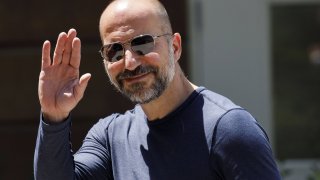
- Uber reported third-quarter financial results that included a first-ever adjusted EBITDA profit.
- The company reported a net loss of $2.4 billion for the quarter. That was largely attributed to a drop in the value of its investment holdings, particularly in Didi.
- Uber said active U.S. mobility drivers were up nearly 60% yea -over year in the third quarter.
Uber reported its third-quarter results after the bell on Thursday. After an initial dip, shares were up about 1% in after-hours trading.
Here's how Uber did, compared with expectations of analysts surveyed by Refinitiv:
Get Connecticut local news, weather forecasts and entertainment stories to your inbox. Sign up for NBC Connecticut newsletters.
- Loss per share: $1.28 vs. 33 cents expected
- Revenue: $4.8 billion vs. $4.4 billion expected
Uber reported a net loss of $2.4 billion for the quarter mostly because of a drop in the value of its investment holdings, particularly in Didi. The company said its stakes in Zomato, Aurora and Joby helped offset some of that loss. Uber posted a net loss of $1.09 billion in the same quarter a year ago.
Uber also reported its first adjusted EBITDA profit, meeting its end-of-year target. (EBITDA refers to earnings before interest, taxes, depreciation and amortization.) The company posted an adjusted EBITDA profit of $8 million, up from an adjusted EBITDA loss of $507 million in the second quarter.
Money Report
Uber's Eats segment has continued to hold up despite pandemic restrictions easing in places across the world. The delivery business had allowed the company to withstand Covid headwinds when people began ordering more at home during the pandemic.
Here's how Uber's largest business segments performed in the third quarter of 2021:
- Mobility (gross bookings): $9.9 billion, up 67% year over year
- Delivery (gross bookings): $12.8 billion, up 50% year over year
Delivery revenue has continued to outperform its core ride-hailing business at $2.24 billion, compared with $2.2 billion, though that gap is narrowing. Freight revenue brought in $402 million. In an update to shareholders, the company said that its number of delivery merchants grew to more than 780,000.
The company has struggled with supply and demand imbalances because of the pandemic, leading to surge pricing and increased wait times.
Uber showed signs of pandemic recovery in the U.S. The company's active U.S. mobility drivers were up nearly 60% year-over-year in the third quarter, and improved through October with 10 consecutive weeks of driver growth since the end of August.
Uber CEO Dara Khosrowshahi said on the company's earnings call that incidents of surge pricing have fallen by nearly half, while wait times are on average less than five minutes.
"We're comfortable that the bulk of our recruitment spending is behind us," he added.
In another sign of the recovery, Uber said trips to and from airports grew 35% quarter over quarter and 203% year over year.
Uber reported 1.64 billion trips on the platform during the quarter, up 9% from the past quarter and 39% year over year. Monthly active platform consumers reached 109 million, up 8% from the prior quarter. Drivers and couriers earned an aggregate $8.6 billion during the quarter.
The company said it anticipates gross bookings between $25 billion and $26 billion in the fourth quarter. It also expects adjusted EBITDA of $25 million to $75 million.
Uber's largest American competitor, Lyft, also reported financial results this week. Lyft beat Wall Street guidance on both the top and bottom lines and said drivers are coming back, though it missed active riders estimates.






